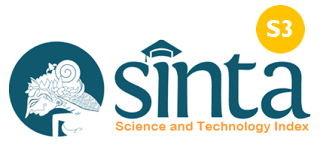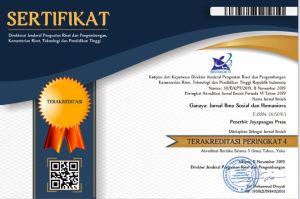Designing Multicultural-Based Contextual Learning Model in Teaching Writing at Chandra Kumala Senior High School
Keywords:
MBCLM, Writing, Design, Teaching ModelAbstract
This research is about designing learning model and part of a R&D research (Research and Development), which aims to; (1) describe the design of Multicultural-Based Contextual Learning Model (MBCLM) at SMAS Chandra Kumala, Deliserdang, (2) find out the effect of Multicultural-Based Contextual Learning Model (MBCLM) to students’ learning at SMAS Chandra Kumala, Deliserdang.This research was designed by incorporating an Authenticity-Centered Approach (ACA) principles proposed by Mishan which focus on the authenticity of learning material. Authenticity needed because it links to students’ contextual or daily lives. The method of this study was qualitative and quantitative research. The design and learning material were validated by two validators. The subject in this study was the students of class XI-A and C senior high school at Chandra Kumala. The instruments used to collect data were questionnaires, syllabus, lesson plan and adjudication sheets of the writing test. The data collector in the form of a questionnaire used Likert scale. The results of this research suggested that the design and learning material produced a very good result where the percentage of them exceeding the minimal standard of percentage criteria (or >75%), while the result of the t-test (by applying Multicultural-Based Contextual Learning Model) showed that the t observed is higher than t table (5.57 ˃ 1.671) at the level of significance of 0.05. Thus, it can be concluded that teaching writing by applying Multicultural-Based Contextual Learning Model affects the students’ writing competenceReferences
Ambarwangi, S. (2013). Pendidikan Multikultural di Sekolah melalui Pendidikan Seni Tradisi. HARMONIA, Volume 13, No. 1, pp. 78-85.
Barus, L. D. G., Herman., and Niswa, K. (2020). The Effect of Student Teams Achievement Divisions (STAD) to the Students’ Writing Ability on Recount Text. Journal of English Education and Teaching (JEET), Volume 4 number 4, December 2020, Page 536-547. DOI: https://doi.org/10.33369/jeet.4.4.536-547
Creswell, J. W. (2012). Educational Research. Boston. Pearson
Fraenkel, J. R, and Wallen E. (2009). How to Design and Evaluate Research in Education. New York: McGraw-Hill.
Herman., Purba, R., Thao, N. V., & Purba, A. (2020). Using Genre-based Approach to Overcome Students’ Difficulties in Writing. Journal of Education and E-Learning Research, 7(4), 464-470. https://doi.org/10.20448/journal.509.2020.74.464.470
Ivantara, E. P., Herman., and Manalu, D. B. (2020). The effect of using cooperative script on students’ reading comprehension at grade eleveth of SMA Negeri 2 Pematangsiantar . Acitya: Journal of Teaching & Education, Vol. 2 No. 2 2020, PP. 82-94. DOI: 10.30650/ajte.v2i2.1361
Kijima, M. (2005). Schooling, Multiculturalism and Cultural Identity: Case Study of Japanese Senior School Students in a Secondary School in South Australia. International Education Journal. Volume 5. No. 5. pp 129-136.
Mansouri, F, and Trembath, A. (2005). Multicultural Education and Racism: The Case of Arab-Australia Students in Contemporary Australia. International Education Journal. Volume 6 No. 4. pp. 516-529.
Naim, N. and Sauqi, A. (2011). Pendidikan Multikultural: Konsep dan Aplikasi. Yogyakarta: Ar-Ruzz Media.
Ningsih, A. W., Sihombing, P. S. R., Silalahi, D. E., & Herman. (2022). Students’ Perception towards the Use of ICT in EFL Learning at Eleventh Grade SMA Negeri 1 Dolok Batu Nanggar. Education and Human Development Journal, 6(3), 24–36
Purba, R., Herman, H., Manullang, V. R. M., and Ngongo, M. (2021). Investigation of Decoding Fillers Used in an English Learning Talk Show “English with Alice”. English Review: Journal of English Education, Vol. 10, No. 1, PP. 37-48. DOI: https://doi.org/10.25134/erjee.v10i1.5352
Rajagukguk, T. A., Herman. H., & Sihombing, P. S. R. (2020). The Effect of Using Collaborative Writing Method on Students’ ` Recount Text at Grade Ten of SMK YP 1 HKBP Pematangsiantar. Acitya: Journal of Teaching and Education, 2(2), 95-114. DOI: https://doi.org/10.30650/ajte.v2i2.1363
Sherly et al. (2021). Socialization for the Implementation of E-Learning Teaching Models for Teachers and Education Staffs at SMA Sultan Agung Pematangsiantar. ABDI DOSEN: Jurnal Pengabdian pada Masyarakat, Vol. 5, No. 2, PP. 275-280, DOI: https://doi.org/10.32832/abdidos.v5i2.879
Silalahi, D. E., Sihombing, P. S. R., Herman, and Purba, L. (2021). High Order Thinking Skill (HOTS) Questions on Learners’ Writing Ability of Report Text at EFL of FKIP Universitas HKBP Nommensen. Jurnal Dinamika Pendidikan, Vol. 14, No. 2, PP. 17-32. DOI: https://doi.org/10.51212/jdp.v14i2.33
Sinaga, H., Herman., and Hutauruk, B. S. (2020). Students’ Difficulties in Using Personal Pronouns in Writing Recount Text. Scientia: Jurnal Hasil Penelitian, 5(1), 29-36. https://doi.org/10.32923/sci.v5i1.1341
Tielman, K. et. al. (2012). Collaborative learning in multicultural classrooms: a case study of Dutch senior secondary vocational education. NAICS. Vol. 64. no. 1. pp.103-118.
Triana, M., Herman, H., Sinurat, B., & Silalahi, D. E. (2021). An Analysis of Students Perception on the Use of Google Classroom in English Language Learning. Cetta: Jurnal Ilmu Pendidikan, 4(3), 607-618. https://doi.org/10.37329/cetta.v4i3.1474
Van Thao, N., Herman, Napitupulu, E. R., Hien, N. T., and Pardede, H. (2021). Code-Switching in Learning via Zoom Application: A Study in an EFL Context. Asian ESP Journal, Volume 17 Issue 3.1, March 2021, ISSN: 2206-0979, PP. 91-111
Yaqin, M. A. (2005). Pendidikan Multikultural. Cross-Cultural Understanding untuk Demokrasi dan Keadilan. Yogyakarta. Pilar Media.
Downloads
Published
How to Cite
Issue
Section
License

This work is licensed under a Creative Commons Attribution-ShareAlike 4.0 International License.
An author who publishes in the Cetta : Jurnal Ilmu Pendidikan agrees to the following terms:
- Author retains the copyright and grants the journal the right of first publication of the work simultaneously licensed under the Creative Commons Attribution-ShareAlike 4.0 License that allows others to share the work with an acknowledgement of the work's authorship and initial publication in this journal
- Author is able to enter into separate, additional contractual arrangements for the non-exclusive distribution of the journal's published version of the work (e.g., post it to an institutional repository or publish it in a book) with the acknowledgement of its initial publication in this journal.
- Author is permitted and encouraged to post his/her work online (e.g., in institutional repositories or on their website) prior to and during the submission process, as it can lead to productive exchanges, as well as earlier and greater citation of the published work (See The Effect of Open Access).
Read more about the Creative Commons Attribution-ShareAlike 4.0 Licence here: https://creativecommons.org/licenses/by-sa/4.0/.





